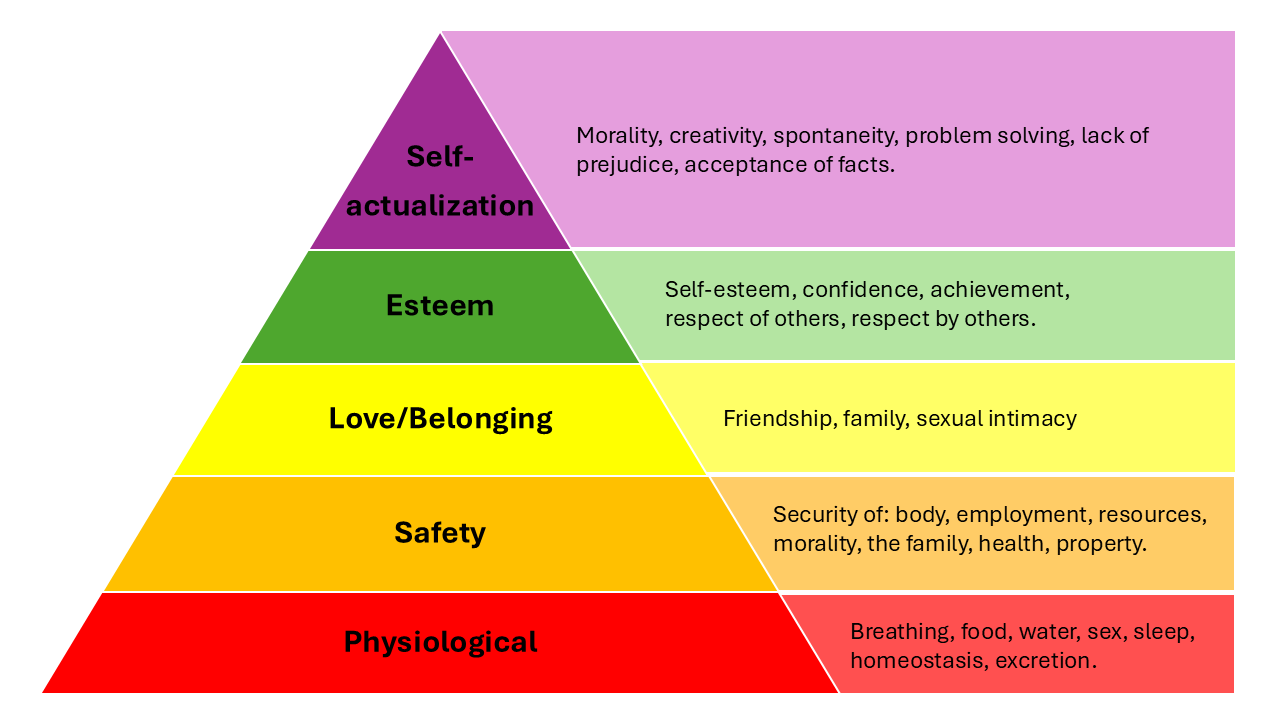Chapter 7: Maslow and His Needs

Warm-Up Questions

- What sorts of things helped you feel happy and safe when you were a child?
- What do you need these days to feel happy and safe?
- How do you say the word psychology in your first language? What have you studied or read about human psychology?
![]()
Read

There is a theory in psychology called Maslow’s Hierarchy of Needs. It deals with five levels of needs that influence and motivate human behaviour. In Maslow’s theory, individuals must meet the needs at the bottom of the hierarchy before meeting the needs at the top. From bottom to top, the needs are Physiological, Safety, Belonging and Love, Esteem, and Self-actualization. Once a need is met, it will go away, and our actions will focus on the next step of the ladder.
Physiological needs, the first step on the ladder, refers to a person’s biological or bodily needs (Mcleod, 2018, p. 4). Food, sleep, shelter, warmth, air and anything the body needs to function properly fits into this category. It is the first step because without meeting these needs, nothing else would be possible.

Safety needs, the second step, refers to our need for security (Mcleod, 2018, p. 4). This step includes order, law, housing, and freedom from fear. These needs must be met so that we feel free to be ourselves and exist safely in our environment.
Third on the list is Belonging and Love (Mcleod, 2018, p. 4). This deals with our need to be social and have interpersonal relationships. This can be anything from romance to work relationships as long as it involves being part of a group. In this step, it is essential to trust others and form close relationships.

Esteem needs are the fourth step, and they pair with safety to form the basis for a person’s psychological needs (Mcleod, 2018, p. 1). Maslow classified this step as having confidence in yourself and the desire for respect from others. A person’s confidence level may come from different sources, including independence and achievements.
Finally, Self-actualization deals with realizing personal potential and growth; it often involves creativity (Mcleod, 2018, p. 4). It is based on the idea of becoming everything that you can become. To Maslow, personal growth and challenging yourself was the final step to becoming a fully realized individual. He specified that the need for personal growth and discovery is always present in a person’s life. It reaches its peak, however, when a person finds a meaning in their life that is important to them (Maslow 1962).
Maslow first created his hierarchy in 1943, although he adjusted it many times throughout his life. As he grew older, he realized the order of steps was flexible. He explained that the order of the steps was not rigid because one need must not be 100% met before we move on to the next need (Maslow, 1987, p. 69). For example, he noted that some people may need self-esteem more than love. For others, creativity may be more important than basic needs. In recent years, people have criticized Maslow’s hierarchy. He did not base his theory on sufficient scientific research or data; instead, it was based mostly on his assumptions. In any case, Maslow made important contributions to the field of psychology. His hierarchy of needs gave us an important theory to help us understand people’s needs and motivations.
![]()
Comprehension Questions
Answer the following questions in complete sentences.
- What is the main idea of the article? Please say it in your own words.
- What are physiological needs? Give some examples.
- What sorts of things are psychological needs?
- Maslow’s theory has a hierarchy of needs. What other hierarchies do you know, for example, at a business, at school, or in a family?
- How did Maslow create his hierarchy of needs? What did he base it on?
- Did Maslow’s theory change over time? Explain your answer.
- When do you change your mind? Give an example of a time that your perspective changed.
![]()
Vocabulary
Category
Data
Finally
Flexible
Function
Hierarchy
Involve
Motivate
Potential
Psychology
Rigid
Security
Source
Specify
Sufficient

Vocabulary Practice
Definitions Exercise
Practise identifying the correct definition for each of the target words.
Parts of Speech Exercise
Read the sentence and guess the part of speech. Turn the card to see if you are correct.
Synonyms Exercise
Drag and drop the synonyms. There are two groups of words.
Fill in the Blanks Exercise
Write in the correct word from the word bank.
Media Attributions
- person holding Happy by Alex Lemon book by Josh Felise is licensed under the Unsplash license.
- Maslow’s Hierarchy of Needs by Open Learning Conestoga is licensed under CC BY 4.0.
- Brown wooden ladder on white concrete wall by Lisa Yount is licensed under the Unsplash license.
- wa woman shaking hands with another woman sitting at a table by https://unsplash.com/@resumegenius is licensed under the Unsplash license.
References
Arizona State University. (2024). EdPlus Voiceover Generator [Voiceover audio generator].
Maslow, A. (1962). Toward a psychology of being. D Van Nostrand.
Maslow, A. H. (1987). Motivation and personality (3rd ed.). Delhi, India: Pearson Education.
McLeod, S. A. (2018, May 21). Maslow’s hierarchy of needs. Simply Psychology.
Microsoft. (2023). Copilot [Large language model].
Tay, L., & Diener, E. (2011). Needs and subjective well-being around the world. Journal of Personality and Social Psychology, 101(2), 354-356. doi:10.1037/a00
Artificial Intelligence Disclosure
- Microsoft Copilot was used as a brainstorming tool for the activities in this chapter.
- The Arizona State University EdPlus Voiceover Generator was used to create the audio recording of the reading, vocabulary words, and parts of speech exercise. Adaptations include modification of speed and/or timing, and comping of output takes.
Psychology - view the definition in the Longman Dictionary of Contemporary English Online [New Tab]
Hierarchy - view the definition in the Longman Dictionary of Contemporary English Online [New Tab]
Motivate - view the definition in the Longman Dictionary of Contemporary English Online [New Tab]
Function - view the definition in the Longman Dictionary of Contemporary English Online [New Tab]
Category - view the definition in the Longman Dictionary of Contemporary English Online [New Tab]
Security - view the definition in the Longman Dictionary of Contemporary English Online [New Tab]
Involve - view the definition in the Longman Dictionary of Contemporary English Online [New Tab]
Source - view the definition in the Longman Dictionary of Contemporary English Online [New Tab]
Finally - view the definition in the Longman Dictionary of Contemporary English Online [New Tab]
Potential - view the definition in the Longman Dictionary of Contemporary English Online [New Tab]
Specify - view the definition in the Longman Dictionary of Contemporary English Online [New Tab]
Flexible - view the definition in the Longman Dictionary of Contemporary English Online [New Tab]
Rigid - view the definition in the Longman Dictionary of Contemporary English Online [New Tab]
Sufficient - view the definition in the Longman Dictionary of Contemporary English Online [New Tab]
Data - view the definition in the Longman Dictionary of Contemporary English Online [New Tab]

